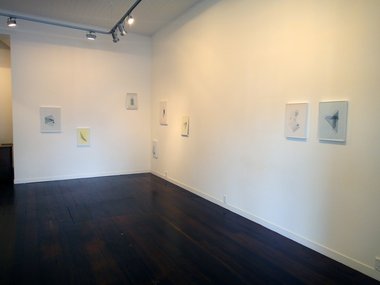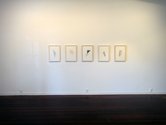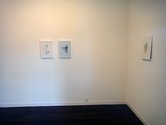John Hurrell – 10 March, 2014
There are several types: the overlapping, loose, oblong sheet combinations; the butted together and overlapping strips; the folded 'tangrams'. Looking at the morphological echoes within each of these ethereal, pallid combinations, you wonder how the rectangular boards themselves determine these slyly tilted arrangements, especially the measured amount of each angle – co-ordinated with ‘reckless’ proximity to the vertical support’s edge.
This exhibition from Kristy Gorman includes five works under glass on embossed paper (with pristine inked in geometric forms and lines, interacting with pressed in shapes), two unframed boards resting on light shelves, and ten boards without glass framed so they look like grainless canvases. The work is airy, full of light, with the filmy ink incredibly delicate. The rendered transparent forms are often ‘folded,’ acutely angled and overlapping.
With allusive hints to a wide range of artists, from Malevich (and so McCahon) to Tuttle and El Lissitzky, the space and forms have a constructivist feel, but with all straight lines - like Suprematism. No saturated colour though, it is always diluted and strangely brittle with its taut edges. Everywhere there is a dominant sense of weightlessness that is typical Gorman. The tones are meticulously even. You compare the empty centres and the tremulous edges.
The Malevich influenced ones have lots of stacked rectangles and parallel lines. Some works are on a tilted plane and exploit the thinness of diluted ink as a medium. With others there is an oft repeated, barely detectable build up towards the edges that accentuates the linear structure, a subtly misty ungranular infusion of weight, a perfectly contained dynamic showcasing these shimmering fields of restrained hue.
There are several types: the overlapping, loose, oblong sheet combinations; the butted together and overlapping strips; the folded ‘tangrams’. Looking at the morphological echoes within each of these ethereal, pallid combinations, you wonder how the rectangular boards themselves determine these slyly tilted arrangements, especially the measured amount of each angle, the tension by means of repeated lean - co-ordinated with ‘reckless’ proximity to the vertical support’s edge. Their asymmetricality works well.
Most strikingly a strange dreamlike quality permeates these clearly defined, but faint, intimate images. They seem to have floated over to Gorman’s studio from another world of timeless geometry, being not ornate or over-fiddly, having no extravagant baroque flourishes or intrusive complexity. Gorman obviously knows the precise moment when to stop adding, when the perfectly balanced structures will collapse if continued, when a haunting and memorable combination has arrived.
John Hurrell













 Two Rooms presents a program of residencies and projects
Two Rooms presents a program of residencies and projects Advertising in this column
Advertising in this column



This Discussion has 0 comments.
Comment
Participate
Register to Participate.
Sign in
Sign in to an existing account.